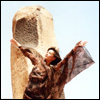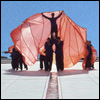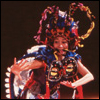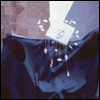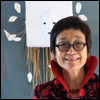Good News
L. A. Weekly January 13, 1984
Yen Lu Wong's Documents From Hell
A New Expressionism
By Susan Block
She greets me, smiling, in a long black skirt and leg warmers, looking like the high priestess of the gymnasium. The gym is large and open, filled with hardly anything but pure, wintry afternoon light. She apologizes for the cold, ushering me over to her "altar" - a melange of video and sound equipment, diagrams, portfolios and heaps of tangled film. She tells me that her life is committed to an ideal, a vision of "all humankind dancing, because of our need for prayer, our need to link ourselves to the cosmos, to root ourselves to the earth." And somehow this conviction tis this gentle little Chinese woman named Yen Lu Wong to the powerful figures, moral outrage and anguish in German Expressionist art.
Since I can't see Documents From Hell (Wong's performance that will be done inn conjunction with the Los Angeles County Museum of Art's exhibition of "German Expressionist Sculpture") before I write this article, Wong plays me some of her music and shows me videotaped dance rehearsals and computer graphics, giving me tastes of the various multimedia aspects of her upcoming premier. I feel as if I am at a great banquet of hors d'ouevres and can't wait to partake in the actual performance "feast".
In a time when the password of contemporary dance seems to be "minimal with a small "m," Wong dares to leap across the decades to connect with the dramatic, emotional, passionately human approach of German Expressionism. Not the Documents From Hell is meant to be a recreation of the work of German Expressionist dancers like Rudolph Laban. Rather, it is Wong's attempt to relate contemporary social and political problems to the themes of the Expressionist movement. In early 20th century Europe, these themes included: war (specifically the shocking, unprecedented devastations of World War I), hope for the new man (that the inner life of humanity could be expressed through art), the mixing of cultures, (Western European with African, Oceanic, and South Sea cultures), and the artist as scientist (two sides of the same coin, both trying to create form from chaos).
In Documents From Hell, Wong's themes run parallel to the Expressionist: the wars in Central America and Asia; the expression of her inner life (maternal especially) through dance; her own Chinese-Californian approach to Italian opera, German cabaret, Latin American folk, American show tunes and new music; and her " artist-as-scientist" explorations into film, video and computer graphics.
Expressionism is not just a hook on which Wong has decided to hang her choreographic cloak. She remembers being touched by the Expressionist movement when she was a little girl in Hong Kong after the Chinese Revolution. She was studying ballet and Peking Opera, learning what she now calls "the dances of never-never land," when she became aware of a new, visceral, political art that she would not forget. She saw only glimpses - a series of Kathe Kollwitz's War and the Mother prints in a literary magazine, handbills featuring Expressionist woodcuts, articles about a dancer named Hsiao-Tang Wu, who had followed the Long March with the Eighth and Fourth Route Armies, performing dances that spoke about oppression, famine and the struggle for liberation. These were just glimpses, but they stuck with her. And after she came to America at the age of 15 and studied with Martha Graham and Alwin Nickolai, among others, they began to pour forth from her work.
Wong didn't come to America to study dance. Dance was not the proper vocation for a nice Chinese girl of the 1940's. She followed her father's wishes that she study medicine, finishing her pre-med studies at Tufts University. "I don't regret having studied medicine," Wong says in her soft, clear voice. "I learned a lot about the inter-relationships of the human body. But is was just not the field for me."
Martha Graham encouraged her to find her own path, a dance that could affirm her cultural heritage and also address contemporary issues. In 1972, she co-founded (with Herbert Shore) The New Repertory and began presenting a variety of works in greatly diverse formats, ranging from intimate ceremonial solos (Cicada Images), to huge-scale epic works in architectural and/or natural environmental settings involving more than 300 people performing over the course of three days (Between Silence and Light I in Australia). Her issues of concern have included her conversion to Catholicism ("wanting to be something other than yourself" - Cicada Images), the Chinese-American experience (Journey to Gold Mountain), and nuclear holocaust (Between Silence and LIght II). In each, she chose the form she felt would best express her concerns.
"I'm not in any camp," she explains "not avant garde, new wave, not punk. I believe I must find my own drum and dance to the rhythm of it... For me, the call of Expressionism has to do with the nonabstract relationship of humans to the environment, which includes other humans."
She flips on the video machine, and a little computer graphic of a man appears on the screen. "His name is Tricky Dick," Wong giggles. "He is my Death Figure." Tricky Dick seems to be bending over an invisible bubble. He turns around and around over and over again, making me rather dizzy, but I can't take my eyes off him. In another sequence, he is punching an invisible adversary. Later he is standing, arms raised in the "V" sign reminiscent of the gesture made y his infamous namesake. Wong explains that between each of the segments of her performance, Tricky Dick will appear on the screen. "There will be six slide projectors," she says. "Some films will play when I dance. But not Tricky Dick. He has the screen all to himself. He commands attention." I nod, still mesmerized by the glowing little computer graphic as he tirelessly turns and turns.
Next, Wong shows me excerpts from her Documents. In contrast to the fine, technologically precise quality of Tricky Dick, this is Wong herself, her strong yet vulnerable features, her delicate limbs, her expressive, sweeping movements. The first piece, "Burden," is the oldest and most German of the documents. Wong began work on it in 1976 as a sketch incorporating the style of Laban. Wong, wrapped in a dark cloak, clutches her moving feet with her hands, her expression stark, accusatory. The opening song from Brecht's Mother Courage segues in to news broadcasts of events in Indochina, the invasion of Grenada, an interview with Marines going to Beirut, a variety of presidents speaking bombastically of America's faith and responsibility. Wong's hands are up, shaking,her mouth wide open as in The Shout by Edvard Munch.
"For the German Expressionists, it was World War I: one traumatic blow, "Wong tells me as she jumps the tape ahead to the next document. "Now war is destroying us piece by piece - in Central America, Beirut, Indochina. War is everywhere now."
In Document #2, "Song of the Mother," Wong takes her choreographic inspiration from the shapes of Expressionist sculpture. A haunting, mournful saxophone by John Gibson (a collaborator with Phillip Glass) sounds something like Tibetan horns, or the long, deep wails of ancient women. wong assumes gestures of grieving, clutching, crying some that are sharply reminiscent of famous sculptures such as Ernest Barlach's Russian Beggarwoman and Kathe Kollwitz's Tower of Mothers.
From the dense, unrelenting anguish of the first two documents, Wong moves into an ironic playfulness in "Nobody's Home," Now she is the "Dead Tech Lady" with long, witch fingers made of hunks of filmstrips and giant pop-up breasts also made of filmstrips ("since I'm in L.A., I use what's plentiful." Wong explains). She sits in a wheelchair, eating credit cards and plastic decals of turkeys as Ethel Merman sings "Everything's Coming Up Roses."
The decal theme stems from Wong's fascination with "Decals for the Bronx," a federal program that has placed large, colorful vinyl decals depicting shutters, potted plants, and window shades over the broken windows of abandoned city-owned buildings that face the Cross-Bronx Expressway. "Instead of fixing up the buildings so people can live in them, they're just dressing up the image so commuters won't have to look at ugly burnt-out buildings," says Wong. "It's all part of the reign of 'dead tech'. Everywhere we go, we're surrounded by it - buildings that people can't live in, telephones that don't work, answering machines that go ga-ga, dishwashers that flood the kitchen, cars that break down. Yet we charge ahead, making more and more, and eventually it all turns to dead tech."
This document is Expressionistic in a more wildly theatrical way. Wong's long fingers make dramatic silhouettes rather like the exaggerated macabre shadows in old German Expressionist films like The Cabinet of Dr. Caligari. She draws her inspiration, in part, from another Expressionist writer's observations about the German people: "They're well-fed, they're well-clothed, but they are afraid." And from this story of a Bronx woman who drove by the decal building in her car: "The building looked so good I came over from my place on Jessup Place to see if I could rent an apartment," she said. Then she examined the windows more carefully. Some showed colorful plants on the sills, some had shutters half-open, some had shutters half-open, some had the shades half-drawn. All were flat, functionless. "Nobody's home," she said, and walked away shaking her head.
The dead-tech film strips of "Nobody's Home" turn into instruments of hope and struggle in "Up Above the Burning Sun," as Wong pulls them across her back like a peasant carrying baskets of corn. Images of death become charged with life. The stark black and white of the first documents changes to earth tones and bizarre old Expressionistic colors like cobalt blue, bright green and orange, The ghost of the Chinese revolutionary dance Hsiao-Tang Wu seems to be moving within Wong as she dances to the music of a bold Chilean march by Inti-Illimani.
Document #5 is Wong's retelling of one of Grimm's fairy tales about a mother who sends her daughter into the forest to save her from impending war. It flows in to the last piece, "Ballad of Doves and Cranes," a lyrical dance with computer-graphic bird sculptures and paper cut-out dolls. "This is a call to the children, " Wong says. "And a question for ourselves: are we going to give them a world to live in, or are we going to let them down?"
As I watch these fragments of videotape, I am intrigued by the eerie, ceremonial quality of Wong's style. No matter how deep her anguish in "Burden," nor how bizarre her condition in "Noboby's Home," all of her movements are extremely formal, as though flowing from some powerful universal tradition. Her grieving postures in "Song of the Mother" resonate with the ancient traditions of formalized grief. Many cultures still ritualize the act of mourning as large, sweeping beating and tearing movements, and loud, piercing wails. In the U.S., we don't have much of a sound-and-movement tradition for mourning our dead. We are, in fact, supposed to "pay our respects" by being quiet and still at funerals. Wong's dance reminds us that our most profound emotions are inextricably related to body movements, especially the movements of the hands: hands outstretched, reaching for hope, hands shaking with fury, a palm on the face, comforting.
As we talk, Wong's 21-year-old daughter comes bounding into the gym with the family dog. Wong springs up to greet her, her "serious artist" expression melting into that "motherly" look of deep concern mixed with pure delight.
"Being a mother myself," Wong tells me later, "I know one thing: motherhood never ends. If a mother's child is killed in war, she never forgets. They say time heals, but I don't think it really does. Five years after that child's death, the mother still hurts when she hears his name."
Kathe Kollwitz had a son who died on the bloody battlefields of World War I. Her grief, indignation, and determination at his death exude from many of her sculptures, such as Tower of Mothers, an imposing monument to motherhood, depicting women attempting to shield their children as they merge into and move with one another - a great mass of maternal solidarity. While creating the piece, Kollwitz wrote in her journal: "This is a new generation and we are grinding them up."
Wong happens to be a member of that "new generation," and she hasn't been ground up: she has survived to witness the next generation being threatened with annihilation. She is also one of the Tower of Mothers, grieving for the children killed in today's unending wars, indignant with the governments that keep them fighting and dying, determined to express her indignation and her grief - in the case of Documents From Hell, through that most direct and passionately human means of expression. Expressionism.
"If I don't speak out," Wong asks as the light in the gym grows dim, "who will?"


